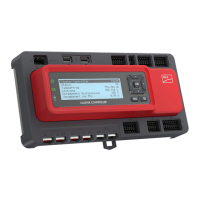• In the drop-down list Signal source, select the desired signal source. Note that the
desired Modbus server must be activated in the ClusterController when you are using the
Modbus (see Section12.1, page60).
• In the drop-down list Predefined Quantity, select the setpoint cosPhi.
6. When using the digital inputs, make the settings for the digital inputs:
• Select the group Settings of digital inputs.
• In the field Failure tolerance time, enter a value above 1 if possible. This prevents e.g.
a brief, simultaneous activation of two relays of a ripple control receiver during a
ClusterController status change being classified as an invalid status.
7. When using the analog inputs, make the settings for the analog inputs:
• Select the group Settings of analog inputs.
• In the field Failure tolerance time, enter the desired time interval.
• In the field Initial value input signal, enter the desired value.
• In the field Final value input signal, enter the desired value.
• In the field CosPhi start setpoint, enter the desired value.
• In the drop-down list Excitation type, select the desired excitation type.
• In the field CosPhi end setpoint, enter the desired value.
• In the drop-down list Excitation type, select the desired excitation type.
8. When using the digital inputs, set the status configuration:
• Select the group Status configuration.
☑ The columns cosPhi and Excitation type are also displayed.
• Depending on the number of digital inputs used in the column Active, activate the
selection field of the status to be configured in each case.
• In the column cosPhi, enter the desired value.
• In the drop-down list Excitation type, select the desired excitation type.
9. Make the settings for the fallback (see Section13.5, page70).
13.5 Making Settings for Fallback
Fallback is an operating mode in the ClusterController used for grid management services.
There are two types of fallback.
• Fallback in case of missing or invalid external setpoint
• Fallback in case of failure of Speedwire communication between ClusterController and
inverters
Fallback in Case of Missing or Invalid External Setpoint
This type of fallback is an operating mode containing setpoints which are implemented by the
ClusterController if it classifies a setpoint as invalid or does not receive a setpoint within a
configurable time. The ClusterController classifies a setpoint as invalid if there is no configuration
for the setpoint available in the ClusterController or if the setpoint is not within the value range
configured in the ClusterController. In the event of an invalid or missing setpoint, the fallback
prevents the ClusterController from continuing to transmit to the inverter setpoints which may no
13 Grid Management Services
SMA Solar Technology AG
User ManualClusterController-BA-en-1570

